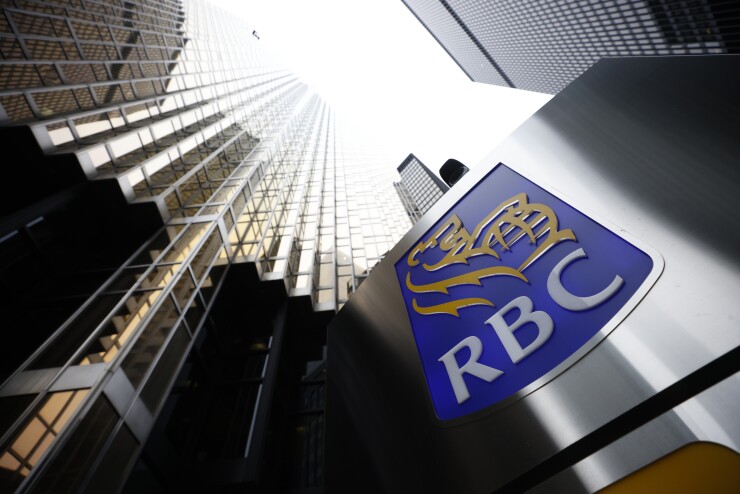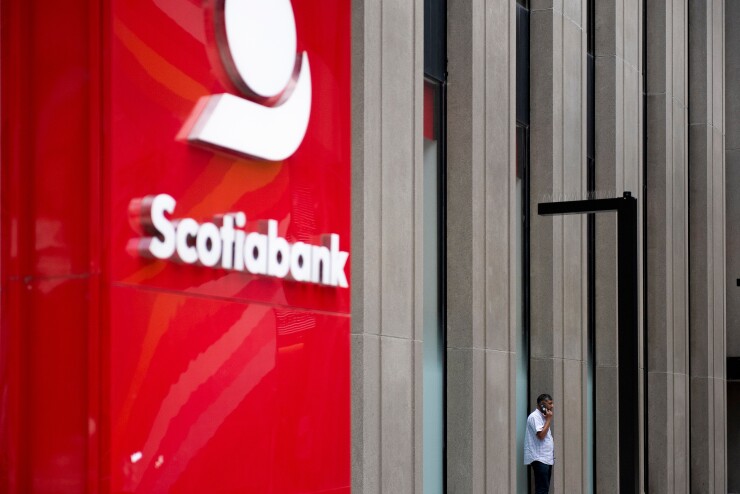Want unlimited access to top ideas and insights?

U.S. bank earnings felt the pressure of President Donald Trump's tariff plays as performance in loan growth and per-share earnings were downcast for many financial institutions. Unsurprisingly, banks and financial firms headquartered outside the U.S. weren't exempt from this
Data released by HSBC toward the end of last month revealed many American corporations have begun to see
Of those in the U.S., 72% reported higher operating costs, and 77% forecasted continually climbing costs. These hikes didn't dim growth expectations however, as 93% reported that they were confident in their ability to
"Most [corporations] are taking a watch-and-wait approach on a short-term basis," Marissa Adams, HSBC's head of trade for Europe and the Americas, told American Banker. "They are very much taking it step by step, waiting to see where things happen."
Read more:
The fallout from Trump's tax plays have driven up loan-loss provisions at institutions like
Tariffs weren't the only challenge facing banks north of the border.
That didn't stop TD from beating analyst estimates for per-share earnings across the three months ended April 30, coming in at CA$1.97 against average estimates for CA$1.78 as per Bloomberg. Credit loss provisions also outpaced expectations, totaling CA$1.34 billion against a predicted CA$1.41 billion.
Read on to gain new insight on international earnings performance below.

What does Wise hope to gain through a U.S. stock listing?
The U.K.-based payments company Wise is testing the initial public offering waters in the U.S. market, in the wake of similar IPO moves from stablecoin issuer
Kristo Käärmann, Wise co-founder and CEO, explained that Trump
"We believe the addition of a primary U.S. listing would help us accelerate our mission and bring substantial strategic and capital market benefits to Wise," Käärmann said.
Other factors that play into the effort's success include the
Read more:

Economic waves lead RBC to up loan-loss provisions
The Royal Bank of Canada boosted its loan-loss provisions by more than 50% quarter over quarter, as Trump's tariff announcements created unrest among consumers and banks alike.
For the three-month period ended April 30, RBC posted a net income of 4.39 billion Canadian dollars ($3.17 billion), slightly under analyst projections for CA$4.54 billion as per S&P. Diluted earnings per share at CA$3.02 and total quarterly revenue at CA$15.67 billion also fell short of respective estimates at CA$3.09 and CA$15.74 billion.
RBC CEO Dave McKay told investors during the bank's most recent earnings call that he was aware that the increased provisions would lead to missed expectations from analysts, but he "still took them at the end of the day, because that's what the scenarios advise us."
"It's not like we spent that money — it goes into an ACL [allowance for credit losses], and if we're wrong, we'll release it," McKay said.
Read more:

BMO overhauls its balance sheet to bolster U.S. performance
BMO Financial Group is shedding specific lower-returning portfolios and moving away from higher-cost deposits to help strengthen the bank's profitability in the U.S.
BMO executives are hopeful that offloading a U.S. credit card portfolio and franchise loan portfolio that failed to meet original return forecasts, combined with reductions in higher-cost certificates of deposit and noncore deposits, will boost its return on equity to roughly 12% sometime in the next three to five years.
"I'm quite impressed with the way our teams aren't just waiting for a rebound in loan demand," CEO Darryl White said during last month's earnings call. "We're on the journey, we're making these moves, and we're executing pretty well against them. And that's before an uptick in loan demand, which, you know, I've been saying this for some time, but it will come one day."
Read more:

Tariff crunch drags down Scotiabank Q2 performance
The prospect of a weakening Canadian economy and recession woes weighed heavily on Bank of Nova Scotia's second-quarter earnings performance.
Scotiabank reported adjusted per share earnings of CA$1.52 for the second fiscal quarter, four cents shy of the CA$1.56 average estimate from analysts according to a Bloomberg survey. Credit loss provisions were up to CA$1.4 billion for the three month period ended April 30, which was higher than the CA$1.34 billion forecast.
"While there are still some headwinds to underlying growth, we believe that this is a result of the operating environment and not necessarily Scotia-specific," John Aiken, analyst for Jefferies Financial Group, said in a note to clients. "Consequently, as investors look past the provisions on performing loans, we believe that the results should be viewed quite favorably."
Read more:

TD's $1B pathway to compliance failure recovery
TD Bank Group is allocating roughly $1 billion toward improving its anti-money-laundering protocols, after suffering $3.1 billion in penalties and an
Previous projections from TD called for $500 million on AML improvements for the fiscal year ending in October, and the bank has spent more than $196 million so far to strengthen its training, analysis standards and other internal processes.
"While we still have work to do, we remain on track with our planned remediation activities and are building the foundational AML program that we need for the years ahead," Leo Salom, who leads TD's U.S. banking operations, said on a call with analysts.
Read more:





